#ancient turkish history
Text
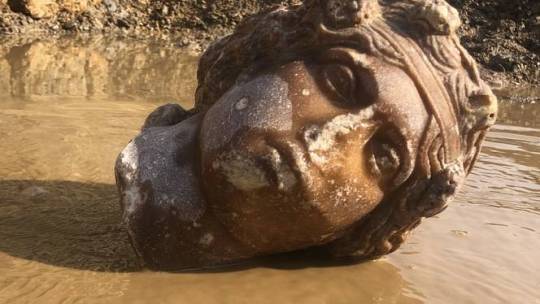
Turkish Archaeologists Unearth Sculpted Heads of Ancient Greek Deities
The excavations in Kutahya province’s ancient city of Aizanoi, which is the site of many ancient Greek and Roman-era settlements, discover the statue heads of Dionysus and Aphrodite.
Turkish archaeologists have discovered more sculpted heads of ancient Greek deities during excavations in Türkiye's western Kutahya province.
The statue head of Aphrodite, known as the goddess of love and beauty in Greek mythology, and the statue head of Dionysus, the deity of wine, were discovered during excavation work in an ancient city in central Türkiye.
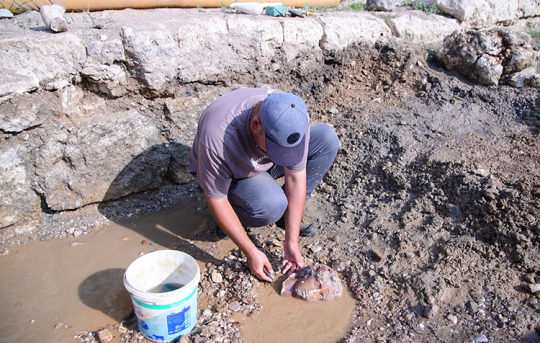
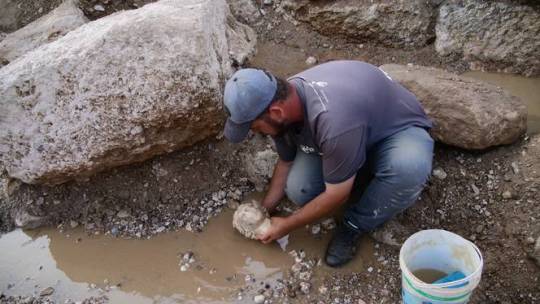
Modern Türkiye is the site of many ancient Greek and Roman-era settlements.
With a history dating back 5,000 years, Aizanoi, situated 50 kilometres (31 miles) from the Kutahya city centre, was included in the UNESCO World Heritage Tentative List in 2012.
Archaeological excavations are currently underway in Aizanoi, which is located in the Cavdarhisar district of Kutahya province and is home to Anatolia's best-preserved Temple of Zeus.
Archaeology professor and excavation team leader Gokhan Coskun told Anadolu Agency that numerous statue pieces were discovered during the excavation.
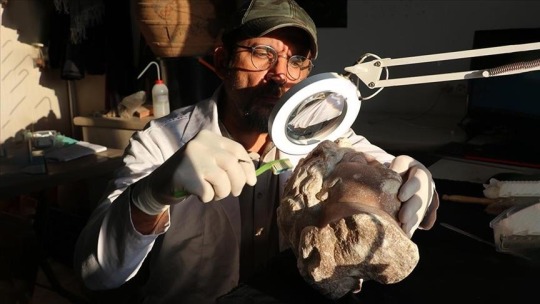
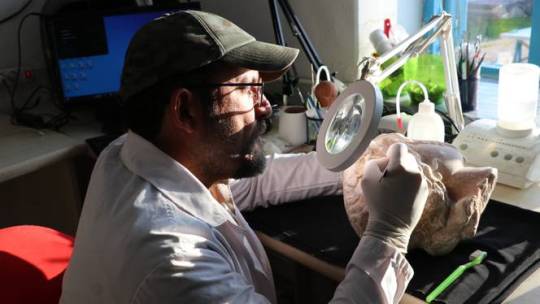
"The most exciting development for us this season is uncovering new heads of the goddess of love and beauty, Aphrodite, and the deity of wine Dionysus," Coskun said.
"In the excavation works we have conducted in the region so far, we have unearthed more than 100 statue pieces. Some of the heads found are from statues that are 2-3 meters long," he noted.
"These statue heads, which we first discovered three years ago, are in very well-preserved condition. During our excavations, so far we have discovered two Aphrodite and three Dionysus statue heads," Coskun said.
The excavation season, which began in the ancient city last April, will be completed by the end of this month, Coskun added.

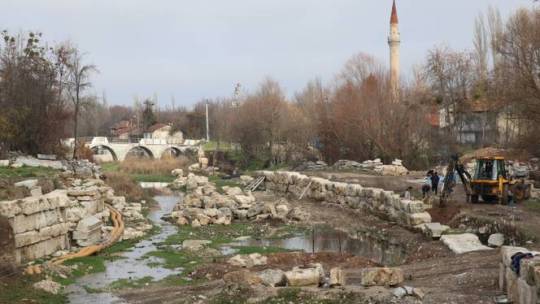

#Turkish Archaeologists Unearth Sculpted Heads of Ancient Greek Deities#ancient city of Aizanoi#Dionysus#Aphrodite#marble#marble statue#marble sculpture#marble head#ancient artifacts#archeology#archeolgst#history#history news#ancient history#ancient culture#ancient civilizations#greek history#roman history#greek art#roman art
299 notes
·
View notes
Text
The Mausoleum of Halicarnassus – the first mausoleum, and known as one of the 'Seven Wonders of the Ancient World,' enthralls with its remarkable architectural design to its use of optical illusions, this ancient site is a testament to the remarkable engineering and craftsmanship of the past.
#Halicarnassus#Mausoleum#Greek#seven wonders#Turkish#reliefs#architecture#ancient#history#ancient origins
32 notes
·
View notes
Text

#coins#Alexander the Great#ancient coins#history#Istanbul Airport Museum#Istanbul Airport#Turkish history#Istanbul#Turkey
3 notes
·
View notes
Photo

(EN) Did you know?🤔
There were at least five temples dedicated to the goddess Artemis in the city of Ephesus, all of which were considered architectural marvels in her time.
Watch this and more in our YouTube video:
"The Story of the Temple of Artemis".
Link: https://youtu.be/Gmre11I46dg
Art by Thorinds
(ES) ¿Sabías qué?🤔
Hubo al menos cinco templos dedicados a la diosa artemisa en la ciudad de Éfeso, todos fueron considerados maravillas de la arquitectura en su tiempo.
Mira esto y mas en nuestro video de YouTube:
"La historia del Templo de Artemisa".
Link: https://youtu.be/Gmre11I46dg
#history#historia#history art#temple of artemis#seven wonders of the world#artemis#artemision#ephesus#ancient greece#4th century bce#greek art#greek temple#turkish history#greek history
11 notes
·
View notes
Photo
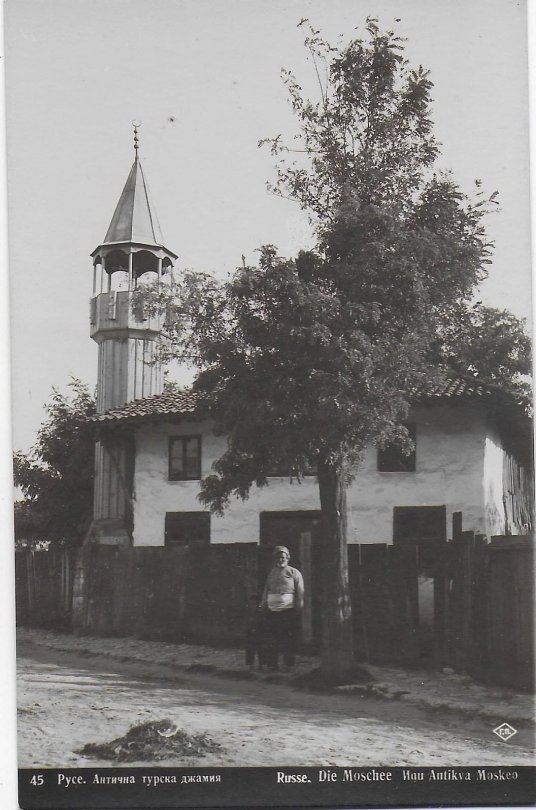
A Turkish man infront of a mosque in Ruschuk/Ruse
#balkan#bulgaria#ruse#ruschuk#history#old#vintage#ancient#turk#turkish#turkey#türkiye#ottoman#rousse#mosque#islam#islamic history#black and white#nostalgic#tradition#traditional#rumeli#bulgaristan#rusçuk#balkan turks#balkan turk#balkan türkleri#osmanlı#tarih#türk tarihi
7 notes
·
View notes
Text

Hierapolis at Pergamon in Turkey
#my edit#my photo#places i'd rather be#sky#pergamon#turkish#turkey#ancient#trip#travel blog#travel bucket list#travel#wanderlust#wandercore#vacation#ef ultimate break#tattoo#girls with tattoos#history#historical
2 notes
·
View notes
Text
i've got a fourth of the book left so who knows this thought may change, but so far my biggest takeway from the agatha christie memoir is that the weird problematic parts and occasional slurs and shit that show up in her books aren't so much raging hateful bouts of racism in the style of young hp lovecraft or raymond chandler
but more an old victorian woman basted in colonialist propaganda and strict classism from birth and surrounded by awful people being politely ignorant and uneducated, and also being very blunt in her quoting real people and writing particular characters
like obviously a lot of that shit is still 100% problematic and deserves criticism and acknowledgement, no question there at all and no being apologist, but it is a bit of a relief that a lot of it is her writing what she saw around her and not necessarily her own personal screeds (chandler was a good noir writer but also so fucking racist holy shit)
#agatha christie#aside from a bit of bewildered culture clash there's been zero slurs or hatred on her personal part in the memoir towards anyone#there's commentary on beautiful turkish women and how polite arabic men are and the beauty of the middle east/egypt and their architecture#and how much she loves studying the ancient history of human civilization in those places#though of course the british relationship with archeology is a whole 'nother kettle of problematic fish#book stuff
1 note
·
View note
Text
Crafting "Hakan's War Manager": A Game Designer's Journey of Struggle and Discovery (Part I)
Check out my latest blog article about my suffering when designing our game "Hakan's War Manager". 🎮📚 Discover the challenges of creating a unique war simulation.
#GameDesign #Hakan'sWarManager #ObaGames
Game development is a complex and challenging process that demands creativity, passion, and a deep understanding of the target audience. As a game designer, I embarked on a journey to create a unique simulation game that combines the elements of early Turkish tribe systems and ancient warfare history. This led to the birth of “Hakan’s War Manager,” a game where players assume the role of a…

View On WordPress
#alternate universe#ancient warfare#early Turkish tribe systems#game design#Hakan&039;s War Manager#historical accuracy#immersive gameplay#innovative game design#merging history and fiction#military formations#simulation game#sports competition#strategy game#war tactics
0 notes
Text

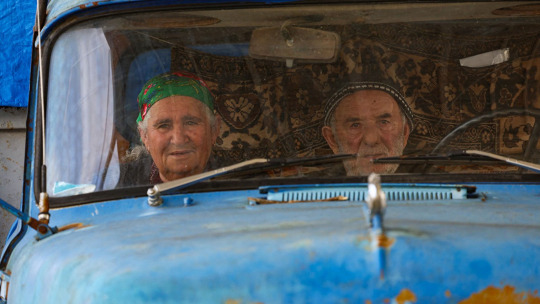

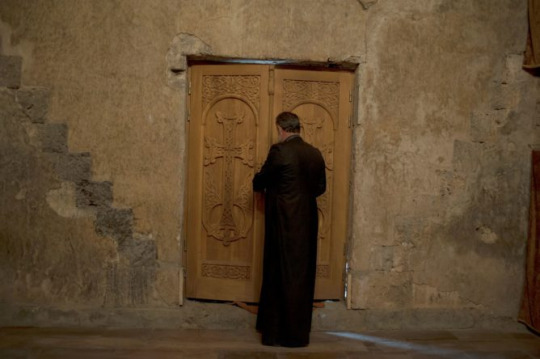
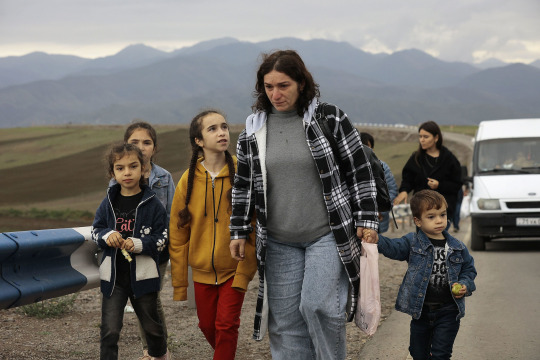

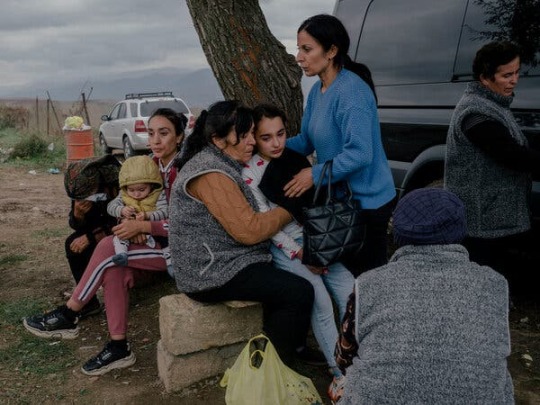



After being starved and imprisoned in blockade for months, 120,000 indigenous Armenians in Artsakh just faced mass deportation and ethnic cleansing at the hands of Azerbaijan, aided by their brother country Turkey and supplied military aid by a third genocidal country, Israel. Noting that in case my American friends think this is a small regional conflict-- guess who funds Israel?
Artsakh will be dissolved on January 1st, 2024 and for the first time in 3,000 years, it will be void of Armenians. Hard to put the pain into words. Turkey and Azerbaijan will not stop here, as pan-turkic doctrine claims all of Armenia as theirs. Armenian existence threatens the fabric of Azeri (and Turkish) national identity so it is no surprise they want to annihlate us again.
With the violent occupation of Artsakh, our ancient holy sites will be desecrated and our history rewritten while major news outlets will find pretty words for genocide like "conflict" or "war". No one will punish Azerbaijan's war crimes, no one will remember white phosphorous rain on our homes. And the perpetrators will continue to live a lie.
I think denial is a fragile basis for any relationship, to a person or to a land. What is built on a foundation of denial will break under enough tension, after enough time. I believe we'll be back someday.
And we are our mountains. I think they will always remember us.
5K notes
·
View notes
Text

Three layers of history in one building!
This home in the Fatih district of Istanbul has ancient Roman foundations under Ottoman-period archways, with the house dating to the start of the Turkish republic (c. 1920's).
📷@bursadabugun
More: https://thetravelbible.com/top-artifacts-from-ancient-rome/
2K notes
·
View notes
Photo

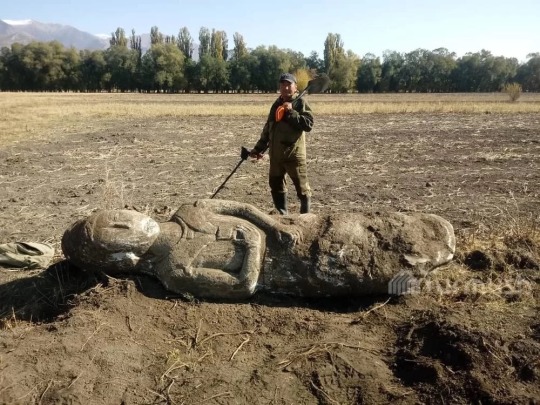
A Giant Stone Statue (Balbal) Found in Kyrgyzstan
A balbal (stone statue) with a height of up to 3 meters was found during agricultural work in the Ak-Bulun village of Tyup district in the Issyk-Kul region of Kyrgyzstan.
Balbal, is the name given to the tombstone that was erected around the grave or some of the kurgan people for the memory of the person in ancient Turks.
Erkin Turbaev, 60, discovered the balbal on October 15 in the evening. When the plow suddenly broke on something, he was preparing to plant potatoes. Turbaev made the decision to dig it out and discovered a more than two-meter-long stone statue at a depth.
Many Balbals have been found in Kyrgyzstan before. Many stone warriors (balbals) of the nomadic Turks are found in Çolpan Ata and Karakol on the shores of Issyk Kul. It is estimated that the balbals were erected in the 6th century. These grave markers in Kyrgyzstan and throughout Central Asia were erected by nomadic Turkish tribes, and almost all of the balbals in Kyrgyzstan are distributed in the Chuy Valley.
The Balbals to the sculptures of the Central Asian Turks, usually in the form of a sword and figure, usually carved on a piece of stone, symbolizing the enemies that the warrior had killed, and the people believed to be his servants in the other world, planted around the tombs of the deceased warriors at the time of widespread preservation of the validity of the shamanic religion.
When the number of these stones is the right of the dead person; the power, the courage, the hero of the hero. The balbals, which is prevalent in the pre-Islamic period, left its place to gravestones after acceptance of Islamic religion. Balbal word is a word from the Old Turkic language and means Bal+Bal (honey + honey), ie hit, cigarette, lighter.
The stone balbals in Kyrgyzstan, which are located on the outskirts of the townships of Sai and Bulak villages, are exhibited in the Kara-Batkak museum.
Historian Zhanbolot Abdykerimov said that many historical monuments can be located on the territory of the rural municipality.
“There are historical kurgans (burials) that date back to the 3rd century BC between the settlements of Ak-Bulun and Frunze. There are such kurgans in Fergana and Almaty. There is historical evidence that the ancient city of Sarybulun [Chigu or Chiguchen – in Chinese sources, the “City of the Red Valley”] was in the eastern part of Issyk-Kul,” the historian noted.
According to Abdykerimov, that the statue has special marks: inscriptions on the head, a pendant in the neck area and a hand in the middle indicating belonging to some title. There are pictures on the back and a belt. A short sword similar to an akinak is drawn. Such weapons were actively used during the Saka period. It is difficult to determine without archaeologists to which period the balbal belongs, the historian noted.
Balbal, which was slightly damaged by tractor drivers during excavations, is 2 meters 70 centimeters long. It was stated that such stone sculptures had not been encountered before in the village.
By Leman Altuntaş.
#A Giant Stone Statue (Balbal) Found in Kyrgyzstan#stone statue#ancient stone statue#ancient artifacts#archeology#archeolgst#history#history news#ancient history#ancient culture#ancient civilizations#nomadic Turkish tribes
61 notes
·
View notes
Text
We all know smoking is an expensive habit but how much would you spend on a single pipe? The best Turkish meerschaum pipes can cost over $7,000!
12 notes
·
View notes
Text

#coins#ancient coins#history#Turkish history#Istanbul Airport Museum#Istanbul Airport#Turkey#Istanbul#numismatics
0 notes
Text
Me: I don’t deny your identity. I acknowledge Palestinians exist today.
Them: Jesus was a Palestinian, not a Jew!
Me: Well, no - he was a Jewish rabbi. He had a bris, kept Shabbat, kept kosher, & his “Last Supper” was a Passover Seder. Besides, nobody would be called “Palestinian” for ~1,900 years after #Jesus died.
Them: Jews are #Khazars with no history in Palestine!
Me: Well, no - millions of DNA samples have now scientifically proven that Ashkenazi Jews (like their Sephardi & Mizrahi brothers & sisters) originate from the Levant (Israel).
Ashkenazi Jews migrated to the Rhineland (western #Germany) between 800-900 CE.
#Yiddish - the language spoken by #Ashkenazi Jews for a millennia - is a mixture of Jews’ original Hebrew & adopted #German.
Meanwhile, there is no evidence of any Khazar influence on Ashkenazi customs, language, or culture.
The #Khazar tale (claiming some or many Turkic Khazars converted to #Judaism), while interesting, is not supported by any archeological evidence, and can be considered nothing more than a story.
Besides, it’s unassailable that the Ashkenazim were living ~1,500 miles from the Khazars, which may as well have been on the moon in the Middle Ages.
Them: Palestinians are Canaanites, the original inhabitants of the Land!
Me: Well, no - there’s zero evidence the Palestinians are Canaanites. This theory followed other similarly false claims over the past several decades that the Palestinians descend from the Philistines (an ancient Aegean Greek “sea people”) and even the Jebusites - a people for whom there is no evidence outside of the Bible of their having ever existed (if they did, they have been gone for at least 3,000 years).
One thing is clear, all of these recent tall tales about Palestinians’ ancient roots in “Palestine” were created in an attempt to delegitimize the State of Israel & not as some academic attempt to find Palestinian roots.
The #Canaanites (who spoke a language similar to #Hebrew, not #Arabic) have been extinct for more than 3,000 years; and there are no #Canaanite influences in any modern Palestinian language, culture, cuisine, customs, or religion.
Furthermore, DNA studies now prove Canaanites are closest in descension to modern-day Armenians & Western Iranians - but, culturally, there has not been a “Canaanite” people in ~3,000 years.
Meanwhile, there is a practically infinite amount of archeological, biblical & non-biblical text, and architectural evidence proving beyond any doubt that Jews lived in the Land of Israel continuously for more than 3,200 years.
Arabs only started arriving in Eretz Israel in significant numbers during the Arab Imperial conquest out of the deserts of the Arabian Peninsula in the mid 7th century CE when the Land was still majority-occupied by ~350,000 Jews.
Arab conquerers #colonized the Land of Israel & subjugated the Jewish majority.
That’s right, the Arabs were the #colonizers - this is historical fact no matter how much that might make your head hurt.
Them: The Jews are foreigners who stole Palestinian land!
Me: Ok, now you’ve officially ticked me off by repeatedly denying MY identity - one that was OBVIOUS to everyone before the last ~55 years when KGB-inspired propaganda went into mass effect in an effort to delegitimize Israel.
Can’t say the same about your identity … even though I keep trying to offer to respect it!
The Arabs only ruled Eretz Israel after conquering it in the 7th century & until they were kicked out by the Seljuks ~400 years later. Never during that time, did they even attempt to establish an Arab or #Muslim state or capital anywhere in Eretz Israel (Jerusalem is never mentioned in the Koran, and while the city is holy to Sunni Muslims, it is not holy to Shia Muslims).
And during the time of Arab rule, there was obviously no state or country called “Palestine.”
Then, during the 400 years before the start of the British Mandate around 1920, the Land was a distant & severely neglected province of the Ottoman #Turkish Empire.
In fact, in the late 19th century, as Jews began moving back to their homeland in larger numbers, there were only ~200,000 people living there (mostly a sparse, nomadic population), and Jews were the majority in #Jerusalem.
Post-WWI, the League of Nations (the precursor to the UN) legally granted Britain a "sacred trust" called the Mandate for Palestine (a name given to the land by Roman Emperor Hadrian in 135 CE).
The Mandate for Palestine was the least controversial of the 15 post-WWI mandates because everyone KNEW Jews were from “Palestine.”
So the Mandate for Palestine, which included the legal requirement for Britain to aid in the establishment of a Jewish National Home, passed unanimously by the League of Nations.
Among other things, the unanimously passed & legally-binding Mandate recognized “the historical connection of the Jewish people with Palestine and to the grounds for reconstituting their national home in that country.”
Besides, before the Jews started returning to the Land in large numbers in the late 19th century, it had become almost entirely war-torn ruins, arid desert & malarial swamps.
But the returning Jews were determined to rebuild their homeland; and the evidence is undeniable that Jewish labor & the Western technology they brought along helped to make the desert bloom again.
The result of a new booming economy in the midst of mostly rural, undeveloped land is no surprise; and hundreds of thousands of Arabs from neighboring lands immigrated to Mandate Palestine in the early to mid 20th century.
In fact, once Arabs began to rebel against the Jews (with pogroms & full-blown barbaric massacres on a particularly wide scale in 1920, 1921, 1929, and in 1936-1939), they made extremely clear to the British that they resented the name “Palestine,” which they claimed (incorrectly) was a modern Zionist invention.
For example, at the British Peel Commission in 1937 (looking into Arab riots from the year before), local Arab leader Audi Bey Abdul-Hadi testified that “[t]here is no such country [as Palestine]! Palestine is a term the Zionists invented!”
Again, during the 1946 Anglo-American Committee of Inquiry that was set-up to make recommendations for the territory, Arab-American historian Philip Hitti testified, “There is no such thing as Palestine in [Arab] history, absolutely not.”
The Arab position was not particularly surprising, as "Palestine” is not an Arab word (Arabic does not even have a letter “P” or a sound for “P,” which is why you often hear Arabs today pronounce it with a “B” as “Balastine”).
The Arabs in the Land at that time mostly identified with their local clan & otherwise considered themselves “Arabs” of “Southern Syria.”
In fact, just about anyone who was called a “Palestinian” pre-1948 was a #Jew.
This is why nobody made any attempt to create a “Palestinian state” during the 19 years between 1948 and 1967 in which #Egypt occupied #Gaza & #Jordan occupied the “#WestBank.”
The hard truth - even though I’m still acknowledging a #Palestinian people exists today - is that an Arab “Palestinian” identity was created for the first time in any signifiant way at the height of the Cold War in the mid-1960s & at the behest of the #Soviet#KGB, which wanted to expand its influence in the region, undermine the only democracy in the Middle East, and which had been repeatedly embarrassed by Israeli victories over invading Soviet-backed & Soviet-armed Arab states.
So the KGB wrote the ridiculous “Palestine Liberation Organization” (PLO) charter & molded Yasser Arafat at what was known as “KGB U” in #Moscow to use #terror & #propaganda to destabilize Israel.
Over the decades since then, many Arabs in the Land have come to self-identify as “Palestinians.”
Even among Palestinians today, however, many still identify with their clan over a separate “Palestinian” nationality (e.g., the clans do not intermarry & many are constantly engaged in some degree of violent conflict).
And the 2 million+ Arabs citizens of the State of Israel (who have equal protection under the law & more rights & privileges than they would have in any Arab and/or Muslim country on Earth) almost exclusively identify as either #Israeli-#Arabs or as simply #Israelis - not as #Palestinians.
Them: #Jews … I mean #Zionists … are bad, ok? Just ask the UN.
Me: Right. Just ask the #UN
Captain Allen
@CptAllenHistory
592 notes
·
View notes
Text
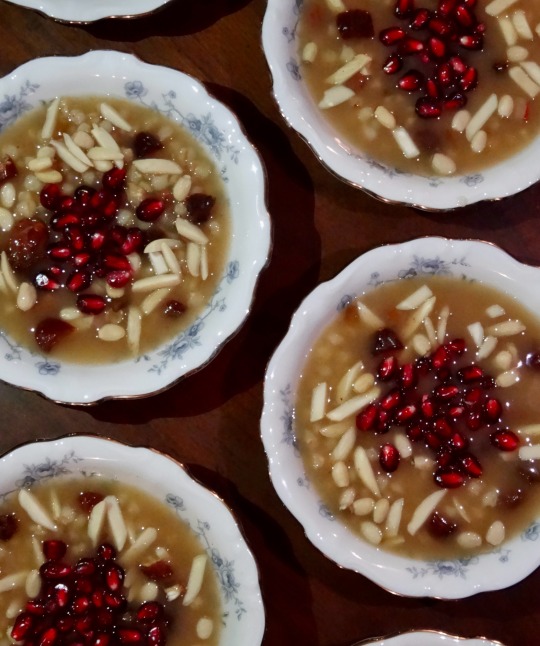
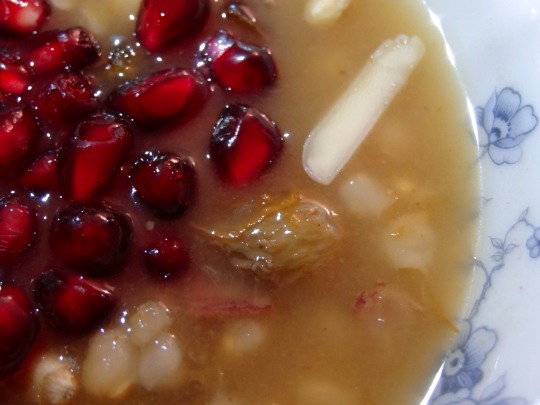
[ID: First image shows four small porcelain bowls of a pudding topped with slivered almonds and pomegranates seeds, seen from above. Second image is an extreme close-up showing the blue floral pattern on the china, slivered almonds, golden raisins, and pomegranate seeds on top of part of the pudding. End ID]
անուշապուր / Anush apur (Armenian wheat dessert)
Anush apur is a sweet boiled wheat pudding, enriched with nuts and dried fruits, that is eaten by Armenians to celebrate special occasions. One legend associates the dish with Noah's Ark: standing on Mt. Ararat (Արարատ լեռը) and seeing the rainbow of God's covenant with humanity, Noah wished to celebrate, and called for a stew to be prepared; because the Ark's stores were diminishing, the stew had to be made with small amounts of many different ingredients.
The consumption of boiled grains is of ancient origin throughout the Levant and elsewhere in West Asia, and so variations of this dish are widespread. The Armenian term is from "անուշ" ("anush") "sweet" + "ապուր" ("apur") "soup," but closely related dishes (or, arguably, versions of the same dish) have many different, overlapping names.
In Arabic, an enriched wheat pudding may be known as "سْنَينِيّة" ("snaynīyya"), presumably from "سِنّ" "sinn" "tooth" and related to the tradition of serving it on the occasion of an infant's teething; "قَمْح مَسْلُوق" ("qamḥ masluq"), "boiled wheat"; or "سَلِيقَة" ("salīqa") or "سَلِيقَة القَمْح" ("salīqa al-qamḥ"), "stew" or "wheat stew," from "سَلَقَ" "salaqa" "to boil." Though these dishes are often related to celebrations and happy occasions, in some places they retain an ancient association with death and funerary rites: qamh masluq is often served at funerals in the Christian town of بَيْت جَالَا ("bayt jālā," Beit Jala, near Bethlehem).
A Lebanese iteration, often made with milk rather than water, is known as "قَمْحِيَّة" ("qamḥīyya," from "qamḥ" "wheat" + "ـِيَّة" "iyya," noun suffix).
A similar dish is known as "بُرْبَارَة" ("burbāra") by Palestinian and Jordanian Christians when eaten to celebrate the feast of Saint Barbara, which falls on the 4th of December (compare Greek "βαρβάρα" "varvára"). It may be garnished with sugar-coated chickpeas and small, brightly colored fennel candies in addition to the expected dried fruits and nuts.
In Turkish it is "aşure," from the Arabic "عَاشُوْرَاء" ("'āshūrā"), itself from "عَاشِر" ("'āshir") "tenth"—because it is often served on the tenth day of the month of ٱلْمُحَرَّم ("muḥarram"), to commemorate Gabriel's teaching Adam and Eve how to farm wheat; Noah's disembarkment from the Ark; Moses' parting of the Red Sea; and the killing of the prophet الْحُسَيْن بْنِ عَلِي (Husayn ibn 'Ali), all of which took place on this day in the Islamic calendar. Here it also includes various types of beans and chickpeas. There is also "diş buğdayı," "tooth wheat" (compare "snayniyya").
These dishes, as well as slight variations in add-ins, have varying consistencies. At one extreme, koliva (Greek: "κόλλυβα"; Serbian: "Кољиво"; Bulgarian: "Кутя"; Romanian: "colivă"; Georgian: "კოლიო") is made from wheat that has been boiled and then strained to remove the boiling water; at the other, Armenian anush apur is usually made thin, and cools to a jelly-like consistency.
Anush apur is eaten to celebrate occasions including New Year's Eve, Easter, and Christmas. In Palestine, Christmas is celebrated by members of the Armenian Apostolic church from the evening of December 24th to the day of December 25th by the old Julian calendar (January 6th–7th, according to the new Gregorian calendar); Armenian Catholics celebrate on December 24th and 25th by the Gregorian calendar. Families will make large batches of anush apur and exchange bowls with their neighbors and friends.
The history of Armenians in Palestine is deeply interwoven with the history of Palestinian Christianity. Armenian Christian pilgrimages to holy sites in Palestine date back to the 4th century A.D., and permanent Armenian monastic communities have existed in Jerusalem since the 6th century. This enduring presence, bolstered by subsequent waves of immigration which have increased and changed the character of the Armenian population in Palestine in the intervening centuries, has produced a rich history of mutual influence between Armenian and Palestinian food cultures.
In the centuries following the establishment of the monasteries, communities of Armenian laypeople arose and grew, centered around Jerusalem's Վանք Հայոց Սրբոց Յակոբեանց ("vank hayots surbots yakobeants"; Monastery of St. James) (Arabic: دَيْر مَار يَعْقُوب "dayr mār ya'qūb"). Some of these laypeople were descended from the earlier pilgrims. By the end of the 11th century, what is now called the Armenian Quarter—an area covering about a sixth of the Old City of Jerusalem, to the southwest—had largely attained its present boundaries.
Throughout the 16th and 17th centuries, the Patriarchate in Jerusalem came to have direct administrative authority over Armenian Christians across Palestine, Lebanon, Egypt, and Cyprus, and was an important figure in Christian leadership and management of holy sites in Jerusalem (alongside the Greek Orthodox and Roman Catholic churches). By the middle of the 19th century, a small population of Armenian Catholics had joined the larger Armenian Apostolic community as permanent residents in Jerusalem, living throughout the Muslim Quarter (but mostly in a concentrated enclave in the southwest); in the beginning of the 20th century, there were between 2,000 and 3,000 Armenians of both churches in Palestine, a plurality of whom (1,200) lived in Jerusalem.
The Turkish genocide of Armenians beginning in 1915 caused significant increases in the populations of Armenian enclaves in Palestine. The Armenian population in Jerusalem grew from 1,500 to 5,000 between the years of 1918 and 1922; over the next 3 years, the total number of Armenians in Palestine (according to Patriarchate data) would grow to 15,000. More than 800 children were taken into Armenian orphanages in Jerusalem; students from the destroyed Չարխափան Սուրբ Աստվածածին վանք (Charkhapan Surb Astvatsatsin Monastery) and theological seminary in Armash, Armenia were brought to the Jerusalem Seminary. The population of Armenian Catholics in the Muslim Quarter also increased during the first half of the 20th century as immigrants from Cilicia and elsewhere arrived.
The immediate importance of feeding and housing the refugees despite a new lack of donations from Armenian pilgrims, who had stopped coming during WW1—as well as the fact that the established Armenian-Palestinians were now outnumbered by recent immigrants who largely did not share their reformist views—disrupted efforts on the part of lay communities and some priests to give Armenian laypeople a say in church governance.
The British Mandate, under which Britain assumed political and military control of Palestine from 1923–1948, would further decrease the Armenian lay community's voice in Jerusalem (removing, for example, their say in elections of new church Patriarchs). The British knew that the indigenous population would be easier to control if they were politically and socially divided into their separate religious groups and subjected to the authority of their various religious hierarchies, rather than having direct political representation in government; they also took advantage of the fact that the ecclesiastical orders of several Palestinian Christian sects (including the Armenian Patriarchate of Jerusalem) comprised people from outside of Palestine, who identified with religious hierarchy and the British authorities more than they identified with the Palestinian lay communities.
British policy, as well as alienating Armenians from politics affecting their communities, isolated them from Arab Palestinians. Though the previously extant Armenian community (called "քաղաքացի" "kaghakatsi," "city-dwellers") were thoroughly integrated with the Arab Palestinians in the 1920s, speaking Arabic and Arabic-accented Armenian and eating Palestinian foods, the newer arrivals (called "زُوَّار" / "զուվվար" "zuwwar," "visitors") were unfamiliar with Palestinian cuisine and customs, and spoke only Armenian and/or Turkish. Thus British policies, which differentiated people based on status as "Arab" (Muslim and Christian) versus "Jewish," left new Armenian immigrants, who did not identify as Arab, disconnected from the issues that concerned most Palestinians. They were predominantly interested in preserving Armenian culture, and more concerned with the politics of the Armenian diaspora than with local ones.
Despite these challenges, the Armenian Patriarchate of Jerusalem came to be a vital center of religious and secular culture for the Armenian diaspora during the British Mandate years. In 1929, Patriarch Yeghishe Turian reëstablished the Սուրբ Յակոբեանց Տպարան ("surbots yakobeants taparan"; St. James printing house); the Patriarchate housed important archives relating to the history of the Armenian people; pilgrimages of Armenians from Syria, Lebanon, and Egypt increased and the economy improved, attracting Armenian immigrants in higher numbers; Armenians held secular roles in governance, policing, and business, and founded social, religious, and educational organizations and institutions; Armenians in the Old and New Cities of Jerusalem were able to send financial aid to Armenian victims of a 1933 earthquake in Beirut, and to Armenians expelled in 1939 when Turkey annexed Alexandretta.
The situation would decline rapidly after the 1947 UN partition resolution gave Zionists tacit permission to expel Palestinians from broad swathes of Palestine. Jerusalem, intended by the plan to be a "corpus separatum" under international administration, was in fact subjected to a months-long war that ended with its being divided into western (Israeli) and eastern (Palestinian) sections. The Armenian population of Palestine began to decline; already, 1947 saw 1,500 Armenians resettled in Soviet Armenia. The Armenian populations in Yafa and Haifa would fall yet more significantly.
Still, the Armenian Patriarchate of Jerusalem maintained its role as the center of Armenian life in Palestine; the compound provided food and shelter to thousands of Armenians during the Battle for Jerusalem and the Nakba (which began in 1948). Some Armenians formed a militia to defend the Armenian Quarter against Haganah shelling during the battle.
In the following years, historical British contributions to the shoring up of insular power in the Patriarchate would cause new problems. The Armenian secular community, no longer empowered to oversee the internal workings of the Patriarchate, could do nothing to prevent embezzling, corruption, and even the sale of church-owned land and buildings to settlers.
In 1967, Israeli military forces annexed East Jerusalem, causing another, albeit smaller, surge in Armenian emigration from the city. Daphne Tsimhoni estimates based on various censuses that the Armenian population of Jerusalem, which had reached 5,000-7,000 at its peak in 1945–6, had fallen back to 1,200 by 1978.
Today, as in the 20th century, Armenians in Jerusalem (who made up nearly 90% of the Armenian population of Palestine as of 1972) are known for the insularity of their community, and for their skill at various crafts. Armenian food culture has been kept alive and well-defined by successive waves of immigrants. As of 2017, the Armenian Patriarchate supplied about 120 people a day with Armenian dishes, including Ղափամա / غاباما "ghapama" (pumpkin stuffed with rice and dried fruits), թոփիկ / توبيك "topig" (chickpea-and-potato dough stuffed with an onion, nut, fruit, and herb filling, often eaten during Lent), and Իչ / ايتش "eetch" (bulgur salad with tomatoes and herbs).
Restaurants lining the streets of the Armenian and Christian quarters serve a mixture of Armenian and Palestinian food. Լահմաջո "lahmadjoun" (meat-topped flatbread), and հարիսա / هريس "harisa" (stew with wheat and lamb) are served alongside ֆալաֆել / فلافل ("falafel") and մուսախան / مسخن ("musakhkhan"). One such restaurant, Taboon Wine Bar, was the site of a settler attack on Armenian diners in January 2023.
Up until 2023, despite fluctuations in population, the Armenian community in Jerusalem had been relatively stable when compared to other Armenian communities and to other quarters of the Old City; the Armenian Quarter had not been subjected to the development projects to which other quarters had been subjected. However, a deal which the Armenian Patriarchate had secretly and unilaterally made with Israel real estate developer Danny Rotham in 2021 to lease land and buildings (including family homes) in the Quarter led Jordan and Palestine to suspend their recognition of the Patriarch in May of 2023.
On 26th October, the Patriarchate announced that it was cancelling the leasing deal. Later the same day, Israeli bulldozers tore up pavement and part of a wall in حديقة البقر ("ḥadīqa al-baqar"; Cows' Garden; Armenian: "Կովերի այգու"), the planned site of a new luxury hotel. On 5th November, Rothman and other representatives of Xana Gardens arrived with 15 settlers—some of them with guns and attack dogs—and told local Armenians to leave. About 200 Armenian Palestinians arrived and forced the settlers to stand down.
On 12th and 13th November, the developer again arrived with bulldozers and attempted to continue demolition. In response, Armenian Palestinians have executed constant sit-ins, faced off against bulldozers, and set up barricades to prevent further destruction. The Israeli occupation police backed settlers on another incursion on 15th November, ordering Armenian residents to vacate the land and arresting three.
On December 28th, a group of Armenian bishops, priests, deacons, and seminary students (including Bishop Koryoun Baghdasaryan, the director of the Patriarchate's real estate department) were attacked by a group of more than 30 people armed with sticks and tear gas. The Patriarchate attributed this attack to Israeli real estate interests trying to intimidate the Patriarchate into abandoning their attempt to reverse the lease through the court system. Meanwhile, anti-Armenian hate crimes (including spitting on priests) had noticeably increased for the year of 2023.
These events in Palestine come immediately after the ethnic cleansing of Լեռնային Ղարաբաղ ("Lernayin Gharabagh"; Nagorno-Karabakh); Israel supplied exploding drones, long-range missiles, and rocket launchers to help Azerbaijan force nearly 120,000 Armenians out of the historically Armenian territory in September of 2023 (Azerbaijan receives about 70% of its weapons from Israel, and supplies about 40% of Israel's oil).
Support Palestinian resistance by donating to Palestine Action’s bail fund; buying an e-sim for distribution in Gaza; or donating to help a family leave Gaza.
Ingredients
180g (1 cup) pearled wheat (قمح مقشور / խոշոր ձաւար), soaked overnight
3 cups water
180-360g (a scant cup - 1 3/4 cup) sugar, or to taste
Honey or agave nectar (optional)
1 cup total diced dried apricots, prunes, golden raisins, dried figs
1 cup total chopped walnuts, almonds, pistachios
1 tsp rosewater (optional)
Ceylon cinnamon (դարչին) or cassia cinnamon (կասիա)
Aniseed (անիսոն) (optional)
Large pinch of salt
Pomegranate seeds, to top (optional)
A Palestinian version of this dish may add pine nuts and ground fennel.
Pearled wheat is whole wheat berry that has gone through a "pearling" process to remove the bran. It can be found sold as "pearled wheat" or "haleem wheat" in a halal grocery store, or a store specializing in South Asian produce.
Amounts of sugar called for in Armenian recipes range from none (honey is stirred into the dish after cooking) to twice the amount of wheat by weight. If you want to add less sugar than is called for here, cook down to a thicker consistency than called for (as the sugar will not be able to thicken the pudding as much).
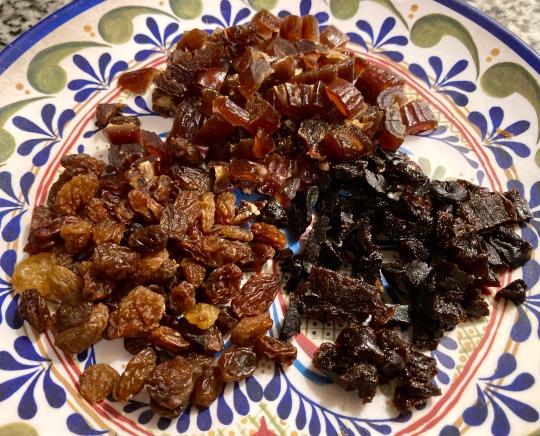
Instructions
1. Submerge wheat in water and scrub between your hands to clean and remove excess starch. Drain and cover by a couple inches with hot water. Cover and leave overnight.
2. Drain wheat and add to a large pot. Add water to cover and simmer for about 30 minutes until softened, stirring and adding more hot water as necessary.

Wheat before cooking
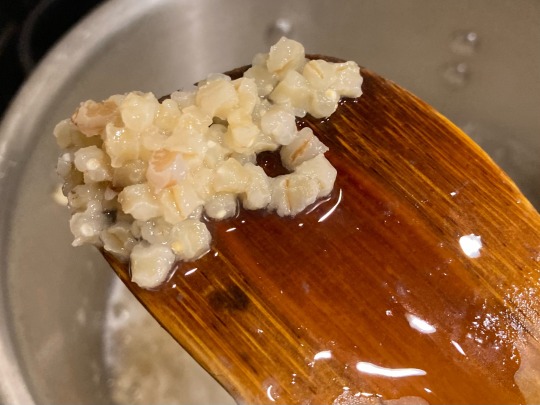
Wheat after cooking
3. Add dried fruit, sugar, salt, and spices and simmer for another 30 minutes, stirring occasionally, until wheat is very tender. Add water as necessary; the pudding should be relatively thin, but still able to coat the back of a spoon.
4. Remove from heat and stir in rosewater and honey. Ladle pudding into individual serving bowls and let cool in the refrigerator. Serve cold decorated with nuts and pomegranate seeds.
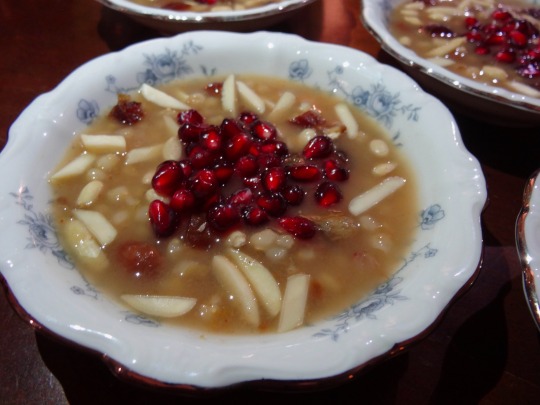
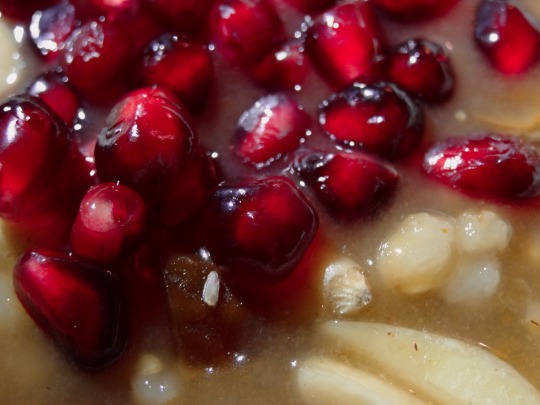
#the last link is a different / new fundraiser#Armenian#Palestinian#fusion#wheat berries#pearled wheats#pomegranate#prunes#dried apricot#dates#long post /
365 notes
·
View notes
Text
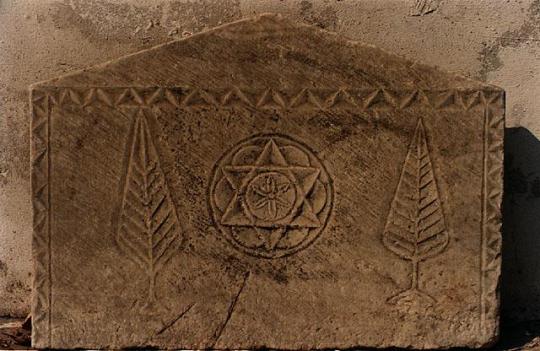

Old tombstones from the Jewish Cemetery in Chios on display in a museum, Greece, ca. 1980
According to Josephus, Yevanic-speaking Jews lived in Chios in ancient times, mostly as Roman slaves. After 1492, Sephardic exiles from Iberia ultimately became the Jewish majority group in Chios, mixing with the already prospered Romaniote, Italqi and Ashkenazi communities. Common occupations for Jews of the time were the making of silk garments, weaving, wine production, and olive and fig farming. They were also involved with the production of the islands' most valuable commodity, mastic. For many centuries, the Jewish life was thriving under the Ottoman Empire alongside, and in harmony with their Greek Christian and Turkish Muslim communities. Everything changed with the start of a chain of wars taking place in the region: the Greek War of Independence, the Ottoman Massacre of Chios, the First Balkan War, the Greco-Turkish War, and finally the Second World War, which effectively ended the long and rich Jewish history of the island.
401 notes
·
View notes